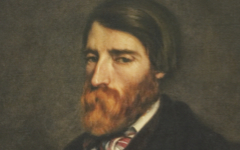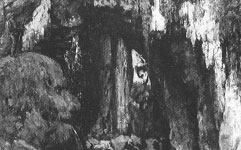Courbet’s The Lovers (1844)
Literalism, taking images at face value, only scrapes the surface of art, leaving the artist’s true interest in picture-making obscured. It is the same with poetry. Yet anyone who wants a deeper understanding of poetic pictures needs to know about the underlying level as a brief look at this painting by Courbet reveals.
Michael Fried, an eminent art historian, described the painting below as a scene of Courbet with his mistress "clasping hands in a forest landscape at dusk." It may seem a reasonable analysis, even patently obvious, but wrong. Both figures, he noted, are posed unconventionally, almost verging on the absurd. They are also very close to the picture surface while their enraptured expressions seem to "involve the suspension of ordinary waking consciousness." In addition, he wrote, the tilting of Courbet's head "towards the picture plane exemplifies the avoidance of face-to-face confrontation."1 Fried is good at noting what is odd about pictures, what features do not fit a straightforward literal reading of the image but, convinced that artists copy reality like photographers, he reads them as such. This is what he should have seen.
There are two realities, combined into one. Courbet is in the studio imagining “a painting of his mistress in a forest landscape” as a reflection of himself. She is his feminine alter ego. In other words, in between these two figures is an invisible mirror. Courbet is “the artist”, his mistress “the painting”, both imagined in Courbet’s mind where the two are fused into one.
Courbet leans towards us, close to the surface, as Fried notes, because he is the artist "outside the picture". His mistress is a reflection of himself which is why their pose is so awkward and why the lighting is inconsistent. The light on her reflects what we would see on the other side of him. His figure is fully rounded because it is "real"; hers is flat because she is in a "painting."
Even though in separate "realities", they can clasp hands in his imagination as a symbol of the intimate connection between an artist and his work and to emphasize the androgyny of his psyche. They are both him. Their enraptured gazes are other-worldly because they are not in this world to begin with; they are in his mind.
More Works by Courbet
Notes:
1. Fried, Courbet's Realism (University of Chicago Press) 1990, p. 69
Original Publication Date on EPPH: 23 Oct 2010. | Updated: 0. © Simon Abrahams. Articles on this site are the copyright of Simon Abrahams. To use copyrighted material in print or other media for purposes beyond 'fair use', you must obtain permission from the copyright owner. Websites may link to this page without permission (please do) but may not reproduce the material on their own site without crediting Simon Abrahams and EPPH.




